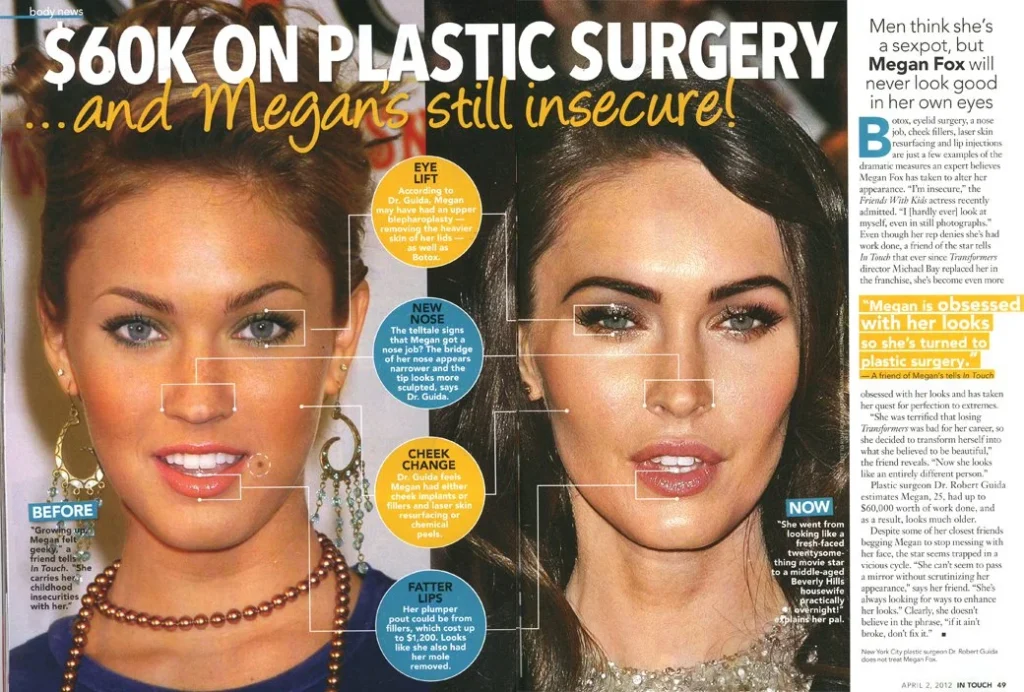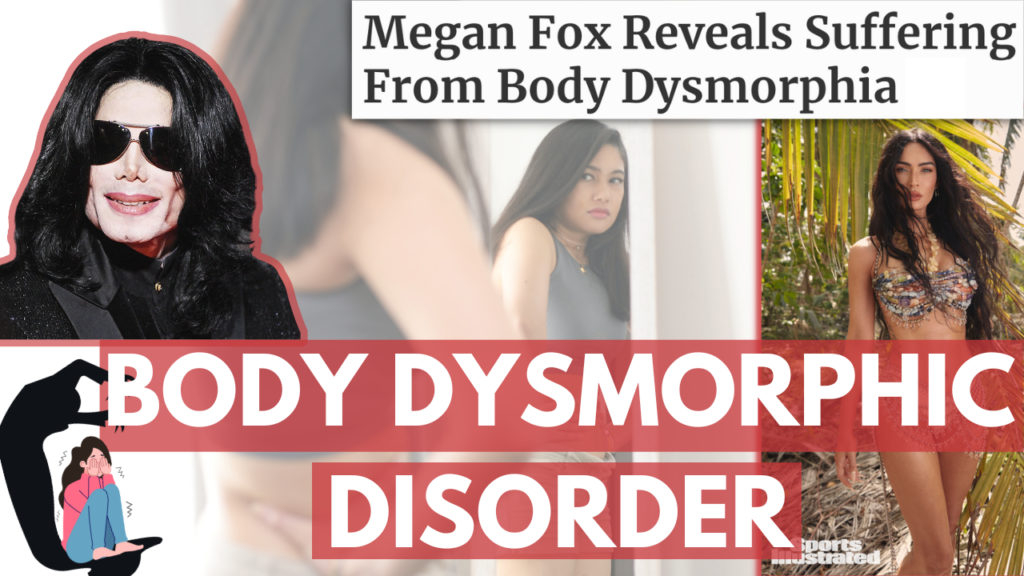VIDEO:
Introduction
In the Sports Illustrated Swimsuit 2023 Issue, Megan Fox courageously revealed her personal struggle with body dysmorphia, drawing attention to the often-misunderstood challenges faced by individuals who battle this mental health condition. Megan Fox, who was previously named the World’s Sexiest Woman by FHM Online’s reader poll in 2008, shared a poignant insight into her experience, stating, “I have body dysmorphia, I don’t ever see myself the way other people see me. There’s never a point in my life where I loved my body, never ever.”

This candid admission highlights the profound impact of body dysmorphia and reinforces the crucial truth that it can affect anyone, regardless of their perceived physical beauty. It is imperative to acknowledge the severity of this mental health issue. In this blog post, we will delve into the depths of body dysmorphia, exploring its definition, recognition, underlying causes, available treatment options, and why aesthetic procedures are not an effective cure.
What is Body Dysmorphic Disorder?
Body Dysmorphic Disorder (BDD) is a mental health condition characterized by an intense preoccupation with perceived flaws in one’s physical appearance. Individuals with BDD experience significant distress and impairment in functioning due to these concerns, which often go beyond normal appearance concerns. It’s essential to understand that BDD is not a superficial or vanity issue but a complex psychological disorder that requires understanding and appropriate treatment.

People with BDD commonly engage in repetitive behaviors as a way to cope with their distress and attempt to address their perceived flaws. These behaviors can include:
- Mirror Checking: They may spend excessive amounts of time examining and scrutinizing their appearance in mirrors or reflective surfaces, trying to find evidence of the perceived flaws.
- Skin Picking or Excessive Grooming: Some individuals may engage in compulsive behaviors such as picking at their skin, excessively plucking hair, or constantly grooming certain areas of the body in an effort to improve or correct perceived imperfections.
- Camouflaging or Concealing: Individuals may resort to applying excessive makeup, using clothing or accessories to hide or distract attention from perceived flaws, or attempting to camouflage specific features through hairstyles, hats, or other means.
- Seeking Reassurance: They may frequently seek reassurance from others about their appearance, constantly asking for validation or confirmation that the perceived flaws are not noticeable or as significant as they believe.
- Comparing and Researching: Many individuals with BDD engage in relentless comparisons to others, or they may spend excessive amounts of time researching procedures, treatments, or products that could address or correct their perceived flaws.
- Avoidance Behaviors: Some individuals may avoid social situations, specific locations, or activities that trigger distress or self-consciousness related to their perceived flaws.
These repetitive behaviors serve as coping mechanisms to manage the distress associated with the perceived flaws. However, it is important to note that these behaviors do not provide lasting relief or resolve the underlying psychological issues.
Potential Causes of BDD:
BDD most commonly develops during the adolescent years, and its development can be attributed to various factors.
Bullying, childhood abuse, genetics, societal pressures, and environmental influences all contribute to the onset of BDD. Individuals who have experienced bullying or childhood abuse may be more susceptible to developing distorted perceptions of their appearance. Moreover, societal pressures, such as unrealistic beauty standards perpetuated by media and social platforms, can fuel feelings of inadequacy and intensify the preoccupation with perceived flaws. Additionally, there is evidence to suggest a genetic component, meaning that if someone in your family has experienced body dysmorphia, it increases the likelihood of others within the family experiencing it as well.
The interplay of these factors underscores the complex nature of BDD and highlights the importance of a holistic approach to understanding and addressing this mental health condition.
Treatment Approaches for BDD:
Effective treatment for body dysmorphic disorder typically involves a combination of psychotherapy and medication. Cognitive-behavioral therapy (CBT) is a widely recognized therapeutic approach that helps individuals challenge their negative beliefs and develop healthier coping strategies. CBT aims to restructure thought patterns, reduce avoidance behaviors, and improve overall well-being. Additionally, medication, particularly selective serotonin reuptake inhibitors (SSRIs), may be prescribed to alleviate associated anxiety or depression.
Why Cosmetic Procedures Are Not The Solution For Patients with Body Dysmorphic Disorder (BDD):
What do Megan Fox and Michael Jackson have in common? Apart from being well-known celebrities, they have both undergone multiple cosmetic procedures in their quest for “improving” their looks.


However, it is important to note that undergoing numerous surgeries as a celebrity in Hollywood is not necessarily indicative of Body Dysmorphic Disorder (BDD). The entertainment industry places great emphasis on looks, where perfection is often seen as the standard. While Hollywood’s obsession with appearances may lead to extensive cosmetic interventions, it is essential to understand that BDD is a distinct psychological condition.

Patients with BDD often turn to plastic surgery and dermatological treatments in the hopes of “solving their problems”. Studies have found that around 15% of plastic surgery patients and 12% of dermatology patients have been diagnosed with BDD. BDD is up to 15 times more prevalent in those seeking plastic surgery.

People with BDD are drawn to cosmetic procedures hoping to fix perceived flaws. However, they often have unrealistic expectations, believing that these procedures will solve all their problems, including issues in other areas of their life. Unfortunately, cosmetic procedures are not designed to address the underlying psychological issues associated with BDD.
Research consistently indicates that individuals with BDD tend to be dissatisfied with the results of cosmetic procedures. They may continue to focus on their perceived flaws or develop new obsessions about different aspects of their appearance.
Due to these factors, BDD is considered a clear contraindication for cosmetic surgeries and procedures.
References
Crerand CE, Franklin ME, Sarwer DB. MOC-PS(SM) CME article: patient safety: body dysmorphic disorder and cosmetic surgery. Plast Reconstr Surg. 2008;122(4) suppl:1–15.
Sarwer DB, Whitaker LA. Psychology of plastic and reconstructive surgery: a systematic clinical review. Plast Reconstr Surg. 2011;128(3):827–8. author reply 828-9.
Bouman T.K., Mulkens S., van der Lei B. Cosmetic professionals’ awareness of body dysmorphic disorder. Plast Reconstr Surg. 2017;139:336–342.
Naraghi M., Atari M. Development and validation of the expectations of aesthetic rhinoplasty scale. Arch Plast Surg. 2016;43:365–370.
Ribeiro, R.V.E. (2017). Prevalence of Body Dysmorphic Disorder in Plastic Surgery and Dermatology Patients: A Systematic Review with Meta-Analysis. Aesthetic Plastic Surgery, 41(4), 964-970. doi: 10.1007/s00266-017-0869-0.




1 thought on “Body Dysmorphic Disorder: Understanding the Condition, Treatment, and Why Cosmetic Procedures Are Not an Effective Solution”
Pingback: How Social Media is Fueling the Rise of Body Dysmorphia – Doctor Contour